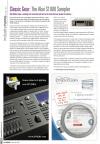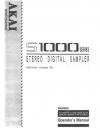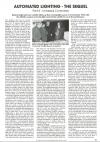NEW PAGE – RESEARCH ONGOING
Timeline
MIDI (Musical Instrument Digital Interface) was developed in 1983.
The MIDI ‘Note‘, related to the musical note that should be played, using a strength of key press (relating to the volume of the note) known as the ‘Velocity‘.
Sequencing Software used MIDI connections between the computer and musical instruments (such as keyboards) or sound modules.
EMR (Electomusic Research) launched a hardware MIDI interface for the BBC Microcomputer in 1984. [ref]
Atari 520ST was launched in April 1985 and had MIDI ports, making it ideal for music sequencing. The 520ST was the first computer to have built-in MIDI ports – other machines could have MIDI ports added externally.
DMX512 was introduced in 1986 as a lighting control standard.
OpCode Systems launched MIDIMAC in 1986 as one of the first (if not the first) MIDI sequencers for Macintosh computers. A hardware MIDI interface with the same name was also launched in 1986 (as the Macintosh did not have MIDI ports).
Cubase (1989) was game-changing MIDI sequencing software which ran on the Atari.
Lighting Control by early computers (not MIDI-related)
- ??USA systems using the Apple IIe
- Intelligent Interface (1985) by Pulsar used a BBC Microcomputer to create a 36 channel control desk.
- ProStar (1986) by the WestStar Corporation ran on an IBM PC and used an external controller with faders and the power of the IBM PC to memorise states. Dimmers were controlled by a series of 24 channel analogue output cards.
- Daslight launched in 1987 running on the Commodore Amiga. The hardware consisted of an interface card which was installed into the Amiga, and software on a 3.5 inch floppy disc. Daslight was one of the first computer based lighting controllers. The first product range consisted of 32, 64 and 128 channel cards all using the 0-10v output protocol. [ref]
Daslight NT was launched in 1994 and ran on Windows NT and Windows 95, and had the ability to output 512 channels of DMX.
In 2002, Daslight launched one of the first USB DMX interfaces.
Sampling & Controlling Samplers
Akai S1000 – Launched in 1988
G-Type: Software by Matt McKenzie, for playback of sound on samplers via MIDI
OpCode Systems: MIDIMAC (1986), Vision or StudioVision (1990) software
MIDI Show Control
Launched in 1991.
Enhanced version of MIDI which expanded the commands within MIDI to include ‘GO’ commands, Cue Numbers etc.
First Sound Desk with MIDI control of routing or mutes
COMING SOON
First Lighting Control desk with MIDI control
The first implementations used MIDI notes or MIDI program changes to trigger scenes in DMX desks, especially so these events could be recorded in a music sequencer alongside the music for synchronized automatic playback.
The Wholehog (1994) had MIDI capability (from the article below)
The desk now offers MIDI for playback purposes. This facility is new and comes with the latest software version 1.10, which points up the advantage of the new generation of ‘soft’ desks; they can expand and develop for the cost to the user of a new software upgrade. MIDI can be either done by the Wholehog’s own timecode list, or you can use adjuncts such as Richard Bleasdale’s SAM Mac. package .
Key People
Charlie Richmond of Richmond Sound Design. StageManager / ShowMan software. [ref]
++
Using MIDI for Lighting Control
Article from Sound on Sound, 1992
MORE COMING SOON
Last updated 16 July 2025



